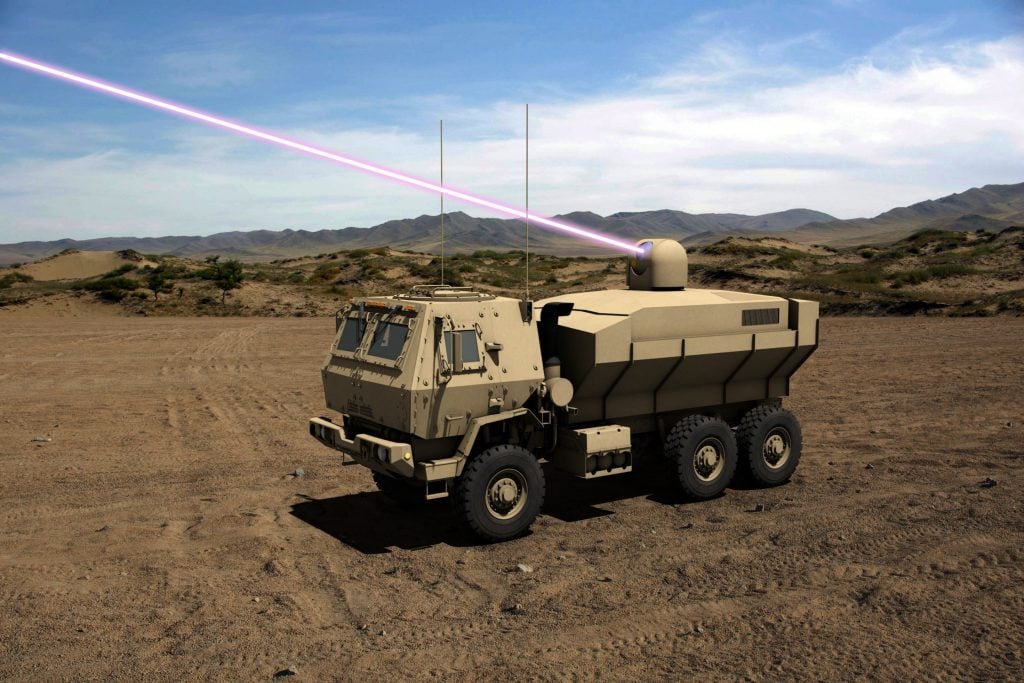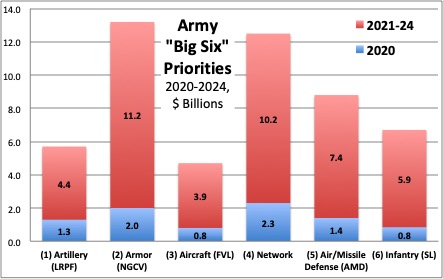Army Will Cull Hypersonic & Laser Weapons Portfolios: Jette & Murray
Posted on
CAPITOL HILL: The Army has let 100 high-tech flowers bloom on directed energy and hypersonics. It is now time to start pruning.
After a two-hour House hearing on the service’s 2020 budget plan, the Army’s point men on modernization gave reporters a sneak preview of the 2021 budget, for which planning is already well advanced. While subcommittee chairman Donald Norcross focused on critiquing proposed cuts to venerable CH-47 Chinook helicopter — built at a Boeing plant just half an hour’s drive from his New Jersey district — the Army leaders he had grilled are already thinking about cuts yet to come on much higher-tech programs.

Army’s 100 kW laser truck to kill drones and incoming rockets, artillery, & mortars, the HEL-TVD. (Dynetics/Lockheed concept)
Offense, Defense, & Dollars
“We are looking across the entire investment portfolio for hypersonics and trying to figure out how we are going to start doing some consolidation,” said Gen. John “Mike” Murray. He was the Army’s funding guru — the deputy chief of staff for programming (G-8) — before becoming the first-ever chief of the newly created Army Futures Command last August.
“It’s too early for me to say ‘this program, that program, this program,'” he said, “but we know that hypersonics are going to be very expensive, and we’re going to have to make a decision on the exact path we’re headed down pretty quick.”
Is anything untouchable? “We’re not committed to anything at this point,” Murray told reporters, “until we figure out how we’re going to streamline the investment and make sure we’re investing against the No. 1 priority.”
Murray’s referring here to what the Army calls Long-Range Precision Fires — in essence, artillery, from howitzers to thousand-mile missiles — which is at the very top of the Army’s Big Six modernization priorities. Army artillery, called a “dead branch walking” at the nadir of Afghanistan and Iraq, is urgently upgrading to counter Russia and China, which have massive numbers of both field guns and non-nuclear missiles.
Besides shooting our own Mach 5-plus hypersonic weapons at the enemy, the Army also needs a better approach to missile defense — priority No. 5 — which is where laser weapons come in. While Star Wars-style blasters are a long way off, there’s near-term promise in defensive lasers to shoot down enemy drones, shells, rockets, and cruise missiles at a fraction of the cost-per-shot of a Stinger air-to-air missile, let alone a Patriot.
The Army’s seeing “great success” with experimental low-powered lasers to kill drones, Gen. Murray told the House Armed Services subcommittee, and the Army hopes to deploy a more potent weapon on the 8×8 Stryker circa 2023. It’s also developing a much larger and more powerful weapon on a heavy truck.
In fact, there are enough initiatives underway in directed energy — which includes high-powered microwaves as well as lasers — that it’s time to start culling the herd, the Army’s civilian chief of acquisition told reporters.
“In some cases, we have multiple programs; the issue then is to figure out how to bring them together,” said Bruce Jette, assistant secretary of the Army for acquisition, logistics, and technology (ASAALT). That does mean some programs will go away, he confirmed, caveating that “we don’t want to be too strict in that process at this point because … there’s still opportunities in more than one path.”
The Army is further along in figuring out its hypersonics portfolio than it is with directed energy, Jette said, because it started on hypersonics about two months earlier.
For both lasers and hypersonics, Jette went on, the Army is working with the other services — because they have to. “There’s not enough money to see if we can compete with the Air Force, the Navy, and DARPA,” he said. “The issue is we ought to find a way to leverage each others’ efforts to get to the right solutions for us.”
While the underlying technologies are the same, the implementation is going to be very different for the Army. “I don’t have a giant ship or a bomber,” Jette said. “I have to deal with it from the ground.”
Army heavy weapons are generally mounted on trucks or armored vehicles, which compared to bombers or warships have much less available space, weight, power, and — especially critical for lasers — cooling capacity. On the upside, ground vehicles don’t have to deal with either the constant vibration of an aircraft or the salty sea air that corrodes everything on a ship. All this makes for very different engineering, let alone tactics.

LRPF: Long-Range Precision Fires. NGCV: Next-Generation Combat Vehicle. FVL: Future Vertical Lift. AMD: Air & Missile Defense. SL: Soldier Lethality. SOURCE: US Army. (Click to expand)
Reforms & Funding
To turn experiments into working weapons, the Army created a new Program Executive Office in December specifically for hypersonics, directed energy, and space programs (which for the Army means mostly satellite communications and navigation). It evolved from the Army’s two-year-old Rapid Capabilities Office (RCO), now reorganized, refocused, and renamed Rapid Capabilities & Critical Technologies Office (RCCTO).
Unlike all other Army PEOs, which have a one- or two-star director reporting to Jette, the RCCTO is led by a three-star officer, Lt. Gen. Neil Thurgood, and answers to a high-level board consisting of:
- Jette, in his capacity as the service’s civilian acquisition executive;
- Murray, in his capacity as Army Futures Command chief;
- Army Undersecretary Ryan McCarthy, one of the most enthusiastic cheerleaders for reform;
- the Army Chief of Staff (currently Gen. Mark Milley, who’s nominated to chair the Joint Chiefs); and
- the Vice-Chief (currently Gen. James McConville, nominated to replace Milley as chief).
Once these six senior officials have approved a project, a RCCTO staffer said during a recent Association of the US Army conference in Huntsville, Ala., it’s exempted from a lot of the regular bureaucracy and protected from budget cuts.
To fund its new priorities, the Army has already cut back or cancelled outright some 186 programs in the budget plan, which covers 2020-2024. The service is now finishing up its proposal for 2021, said Lt. Gen. James Pasquarette, who succeeded Gen. Murray as G-8. The budget will go to the Office of the Secretary of Defense in August, then to the White House Office of Management and Budget, before finally being published and presented to Congress early next year.
The 2020-2024 proposal reallocated $33 billion from lower-priority programs to the Big Six. That massive muscle movement required the Army’s top four leaders — Secretary Mark Esper, Undersecretary McCarthy, Chief of Staff Milley, and Vice Chief McConville — to spend over 60 hours in what staffers called “night court,” deciding the fate of every single Army program. Each hour for the four leaders, of course, required many hours of preparation and implementation by their subordinates — staff work Gen. Murray said he hopes to streamline with more use of computer models that automatically display the impact of each change.
The 2021-2025 plan will probably make smaller adjustments — but there will still be changes. This time, the top four leaders have delegated the program-by-program decisions to Jette and Murray. That puts them, more than ever, on point to make hard calls about the Army’s future.
Subscribe to our newsletter
Promotions, new products and sales. Directly to your inbox.




